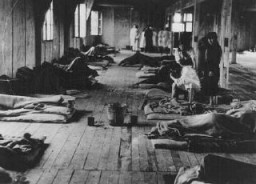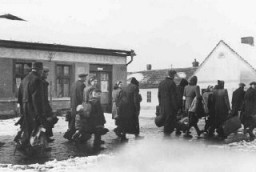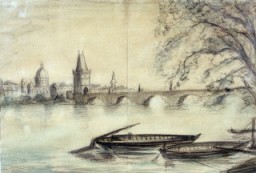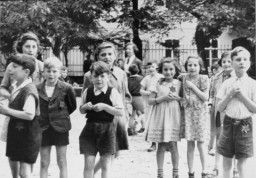
Theresienstadt: Red Cross Visit
Succumbing to pressure following the deportation of Danish Jews to Theresienstadt, the Germans permitted representatives from the Danish Red Cross and the International Red Cross to visit in June 1944. It was all an elaborate hoax. The Germans intensified deportations from the ghetto shortly before the visit, and the ghetto itself was "beautified." Gardens were planted, houses painted, and barracks renovated. The Nazis staged social and cultural events for the visiting dignitaries. Once the visit was over, the Germans resumed deportations from Theresienstadt, which did not end until October 1944.
Danish leaders—from King Christian on down—were insistent that the Danish Red Cross visit the Danish deportees to gather firsthand information on their treatment in Theresienstadt. German diplomats felt that German standing in Denmark and Sweden would deteriorate, to a point harmful to German interests. The Wehrmacht (German armed forces) wanted peace and quiet in Denmark, and the Germans hoped, in Sweden, to continue to import ball bearings needed for the war effort. Under considerable pressure, the Reich Security Main Office (RSHA) agreed to consider the matter and, at the end of 1943, ordered the Theresienstadt camp-ghetto authorities to "prepare" the facility. After considerable stalling, the RSHA finally authorized a visit for representatives of the International Red Cross and the Danish Red Cross for June 1944 and ordered the SS staff in Theresienstadt to complete the preparations.
Elaborate measures were taken to disguise conditions in the ghetto and to portray an atmosphere of normalcy. The SS engaged the Council of Jewish Elders and the camp-ghetto "residents" in a "beautification" program. Prisoners planted gardens, painted housing complexes, renovated barracks, and developed and practiced cultural programs for the entertainment of the visiting dignitaries to convince them that the "Seniors' Settlement" was real. The SS authorities intensified deportations of Jews from the ghetto to alleviate overcrowding, and as part of the preparations in the camp-ghetto, 7,503 people were deported to Auschwitz between May 16 and May 18, 1944.
On June 23, 1944, as planned, two delegates from the International Red Cross and one from the Danish Red Cross visited the ghetto, accompanied by Theresienstadt commandant SS First Lieutenant Karl Rahm and one of his deputies. The facility had been "cleaned up" and rearranged as a model village. Hints that all was not well included a bruise under the eye of the "mayor" of the "town," a part played by Paul Eppstein, the Elders' Council member representing German Jews. Despite these hints, the International Red Cross inspectors were taken in. This was in part because they expected to see ghetto conditions like those in occupied Poland with people starving in the streets and armed policemen on the perimeter.
The Jewish administration, under duress from the Germans, treated the visiting delegation to the trial of a person "charged" with theft, which "just happened" to be taking place; a soccer game in the camp square complete with cheering crowds; and a performance of the children's opera Brundibár, performed in a community hall built specifically for this occasion.
As a result of preparations for the Red Cross visit, the summer of 1944 was, as one survivor later wrote,
"the best time we had in Terezín. Nobody thought of new transports."
In the wake of the inspection, SS officials in the Protectorate produced a film using ghetto residents as a demonstration of the benevolent treatment the Jewish “residents” of Theresienstadt supposedly enjoyed. In Nazi propaganda, Theresienstadt was cynically described as a "spa town" where elderly German Jews could "retire" in safety.
When the film was completed, SS officials deported most of the "cast" to the Auschwitz-Birkenau killing center. Despite the effort involved in making the propaganda film, the German authorities ultimately decided not to screen it.
Series: Theresienstadt
Critical Thinking Questions
- What was the role of Theresienstadt in the Nazi strategy of deception? How was it different from the majority of concentration camps and ghettos?
- Did other camps have multiple purposes? If so, what were they?
- Euphemisms, mild or indirect words or expressions substituted for ones considered to be too harsh or blunt, can hide dangerous or illegal behavior. What expressions did the Nazis use to disguise their intentions or policies?
- Study the visit to this camp by the Danish and International Red Cross delegations. How and why was the reality of the camp disguised from them?







